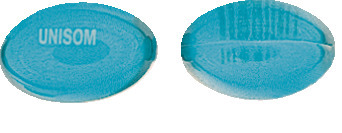What is in this leaflet
This leaflet answers some common questions about Unisom SleepGels, it does not contain all the available information.
Always follow the advice of your doctor or pharmacist, even if it differs from this leaflet.
This leaflet does not take the place of discussion between you and your doctor or pharmacist.
Read this leaflet carefully before starting Unisom SleepGels and keep it with your medicine. You may need to read it again.
Medicines can cause side-effects, some of which can be serious.
Check with your doctor or pharmacists to see if you need to take special care when taking Unisom SleepGels or if you need further information.
What Unisom Sleepgels are for
Unisom SleepGels are for the temporary relief of sleeplessness. If you have difficulty falling asleep Unisom SleepGels may help. Each SleepGel contains diphenhydramine hydrochloride, a substance that acts as an inhibitor of histamine at H1 receptor sites and has additional sedative properties.
Before you take Unisom Sleepgels
Do not take Unisom SleepGels if:
- you have ever had an allergic reaction to Unisom SleepGels, Benadryl, Dramamine or similar medicines
- you are allergic to any of the ingredients listed at the end of this leaflet
- you have asthma, glaucoma, benign prostatic hyperplasia, stenosing peptic ulcer, pyloroduodenal obstruction, bladder neck obstruction or are receiving antidepressant therapy.
Use in children and infants
Unisom SleepGels should not be given to children under 12 years of age.
Do not use Unisom SleepGels if you are breastfeeding
How to take Unisom Sleepgels
Take Unisom SleepGels only as directed.
The dosage is one SleepGel at bedtime.
If sleeplessness persists continuously for more than 7 to 10 consecutive nights, consult you doctor. Insomnia may be a symptom of a serious underlying medical problem.
Avoid alcoholic drinks while taking Unisom SleepGels.
Do not take this product if you are already taking sedatives or tranquillisers without first consulting your doctor.
Overdose
Immediately telephone your doctor or Poisons Information Centre 131126, or go to Casualty at your nearest hospital if you think you or anyone else may have taken too many Unisom SleepGels, even if there are no signs of discomfort or poisoning. You may need urgent medical attention.
Keep telephone numbers for these places handy.
While you are using Unisom Sleepgels
Make sure that your doctor, dentist and pharmacist know that you are taking Unisom SleepGels.
Do not give this medicine to anyone else even if their symptoms seem the same as yours.
Things to be careful of
- Be cautious about driving a vehicle or operating any machinery after taking this medicine. You may still be affected in the morning.
- You should avoid taking alcohol while using Unisom SleepGels.
Side-effects
Check with your pharmacist or doctor as soon as possible if you have any problems while taking Unisom SleepGels.
Side-effects with this type of medication vary in incidence and severity with each user but are usually minor and temporary.
The usual side-effects include lassitude, dizziness, unco-ordination, dry mouth, blurred vision, urinary difficulty and retention, constipation, gastro-intestinal disturbances.
Tell your doctor immediately, or go to your nearest hospital if you notice any of the following:
- changes in heart rhythm
- chest pain
- dizziness
- shortness of breath
- symptoms of allergy such as skin rash
These symptoms are usually rare but may be serious and need urgent medical attention.
Interactions
Monoamine oxidase inhibitors (Nardil, Parnate) prolong and intensify the side-effects mentioned above.
After using Unisom Sleepgels
Storage
Keep your medicine out of the reach of young children. A locked cupboard at least 1½ metres above the ground is a good place to store medicines.
Keep your medicine in its pack until it is time to take it.
Do not keep your Unisom SleepGels or any other medicine in the bathroom or near a sink.
Do not leave it in the car on a hot day.
Keep it in a cool, dry place where the temperature stays below 25°C. Heat and dampness can destroy some medicines.
Product information
What it looks like.
Unisom SleepGels are smooth, oval, pale blue soft capsules containing a clear to pale blue fluid. Each capsule is imprinted "UNISOM" in white.
Ingredients
Active ingredients:
Diphenhydramine hydrochloride - 50mg
Inactive ingredients:
Macrogol 400, glycerol, gelatin, sorbitol, propylene glycol, titanium dioxide, shellac, brilliant blue FCF, purified water.
Manufacturer
Unisom SleepGels are supplied in Australia by:
Pfizer Pty Limited
ACN 008 422 348
38-42 Wharf Road
West Ryde NSW 2114
Unisom SleepGels - AUST R 55323
This leaflet was prepared on 8 February 1996
Published by MIMS May 1999

